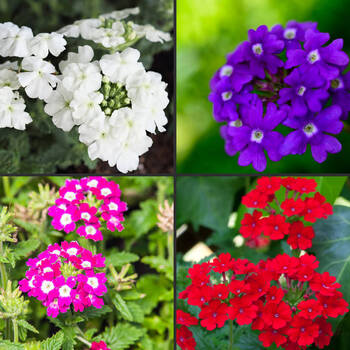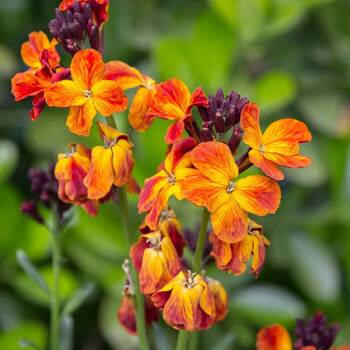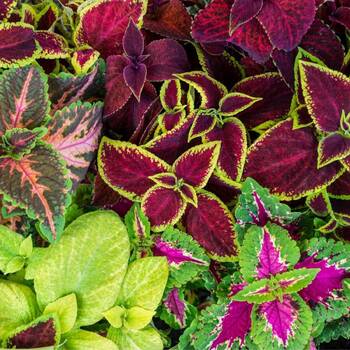Seeds included in 'Flowers | Tropical Climate | Summer 2023' Seed Subscription:
 |
Aster- Hulk (Callistephus chinensis)Bushy annual, 60cm high with unique cream to yellow flowers resembling 'fried eggs'. Ideal for commercial cut flower growers, blooming from late spring to autumn. Suitable for beds, borders, and containers. Easy to grow. Also known as 'China Aster'. |
 |
Zinnia- Mazurkia (Zinnia elegans)Annual grows to 30cm, with large, cream-tipped scarlet flowers up to 8cm wide. Mostly double/semi-double flowers. Ideal for beds, borders, mass plantings. Easy to grow in large containers. Fleuroselect award winner. |
 |
Garland- Serrate Leaf (Glebionis coronaria)Annual plant growing to 80cm. Has dark green serrated leaves, edible raw or cooked. Strong flavour, ideal for soups and stir-fries. Fast growth, heavy production. Also known as "Chop Suey Greens" or "Shungiku". |
 |
Celosia- Forest Fire (Celosia argentea var. plumosa)Annual plant growing to 70cm with dark red/purple foliage, producing fire-red flowers. Ideal for garden beds, borders, mass plantings. Excellent as fresh or dried cut flower. Long flowering. Suitable for containers. |
 |
Forget Me Not, Chinese- Firmament Indigo Blue (Cynoglossum amabile)Annual growing to 40cm. Compact bushy plant with hairy grey/green leaves and small deep blue flowers. Good for borders and as a cut flower. Also known as 'Hounds Tongue'. |
 |
Verbena- Florist Mixed (Verbena bonariensis)Trailing perennial often grown as an annual, growing to 30cm. Attractive fragrant flowers in a mix of colours. Good in rockeries and as a ground cover. Long flowering. |
 |
Wallflower- Fire King (Erysimum cheiri)Evergreen perennial normally grown as a biennial. Grows to 45cm. Dark green foliage with bright orange/red flowers. Sweet fragrance. Good for rock gardens, beds, borders and along walls and fences. Makes an eye-catching cut flower. |
 |
Californian Poppy- Ivory Castle (Eschscholzia californica)Annual plant growing to 40cm with grey/green fern-like foliage. Produces creamy white blooms with yellow centre's. Good as a cut flower, in beds, borders or rock gardens. Ideal for cottage gardens or meadow planting. Grows in poor soil. Drought tolerant. |
 |
Impatiens- Camellia Flowered Mix (Balsam) (Impatiens balsamina)Annual growing to 45cm. Fleshy green foliage. Large double flowers in a range of colours including violet, scarlet, rose, salmon and white. Grows well in shady positions. Can be grown in containers. Impatiens balsamina is also known as Balsam. |
 |
Coleus- Mixed Rainbow (Plectranthus scutellarioides)A 50cm annual plant known for its vibrant, velvety leaves. Comes in solid or bi-coloured shades. Ideal for indoor use, shady gardens, and pots. Prefers shady spots and moist soil. Also called "Painted Leaves" or "Painted Nettle". |
Summer Gardening
Tips for gardening in summer:
- Watering: Learn when to water by using your index finger to check soil moisture. Scratch back a little of the surface soil and use your finger to see if soil is moist about 5cm below the surface; if it’s on the dry side, it’s time to water. Learn more here.
- Pinch for More Flowers: Pinch the main stems of flowering plants to encourage strong growth, a bushier habit and more flowers. Once plants are 20-40cm tall and have several sets of leaves, use sharp, clean snips or secateurs to cut off the top 10cm or so of the main stem of the plant, making the cut just above a set of leaves. Flowers including aster, zinnia, chrysanthemum, calendula, marigold and dahlia will all benefit from pinching. Learn more here.
Pests and diseases to look out for in summer:
- Aphids: Small, sap-sucking insects that congregate on the new shoots or the underside of leaves. They can cause leaves to wilt or become discoloured, and also excrete honeydew which can attract ants and other insect pests. To manage aphids, remove them by spraying with a garden hose, apply a soap or alcohol spray, or encourage predatory insects to your garden. Learn more.
- Whitefly: A sap-sucking insect related to aphids, whitefly are found in large numbers on the underside of leaves, and will swarm in clouds when disturbed. Plants may have yellowing leaves or may wilt, and growth will be slowed. Whitefly can be removed with a Graden hose or strayed with soap spray. Badly affected plants should be destroyed. Learn more.
- Fungal diseases: The combination of warm temperatures and summer humidity can form the perfect conditions for fungal diseases to spread. Water plants in the morning at ground level, avoiding wetting foliage wherever possible. Prune off affected foliage, space plants to allow more airflow, and treat fungal outbreaks with homemade or purchased sprays.
